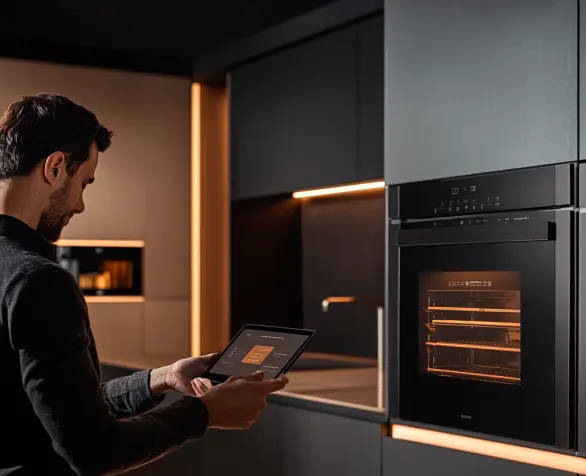A dependable stove is the backbone of most kitchens. From weeknight dinners to big family gatherings, it works behind the scenes to keep everything on schedule. But when your oven stops working properly, it can derail more than just your meal plan.
You can fix most oven problems on your own with a bit of know-how, and sometimes a quick trip to Bunnings for a spare part. Here are the most common oven issues and how to tackle them.
Your Oven Isn’t Heating Up
Few things are more frustrating than food that stays stubbornly raw, even after hours in the oven.
If your oven isn’t heating properly, it’s usually because the oven coil or the thermostat isn’t working as it should. Start with a quick check: take a look at the coil. If it’s cracked, blistered, or obviously damaged, replacing it is usually simple and won’t break the bank.
Next, test the thermostat with a multimeter to make sure it’s doing its job. If the thermostat checks out, make sure your temperature settings are accurate and the oven isn’t overloaded—both can cause uneven cooking.
Finally, don’t underestimate the power of a good clean. Built-up grease and crumbs can restrict airflow, leading to heat fluctuation issues. A quick scrub with Selleys or Easy-Off can make a noticeable difference.
For more stubborn grime, professional stove cleaning services can help restore performance and hygiene in no time. Regular inspections and cleaning go a long way toward preventing bigger problems later.
The Door Won’t Close Properly
An oven door that won’t close is more than just annoying. It also bleeds heat, wastes energy, and leaves your food half-cooked.
Check the rubber gasket, which you might also know as the door seal, before doing anything else. If it’s cracked, brittle, or peeling away, it needs replacing.
Seals are relatively cheap and widely available, which is a good thing, as they make all the difference in keeping heat where it belongs.
Having checked that, take a look at the hinges. Loose screws or bent parts can prevent the door from sitting flush. Tighten what you can, but if the hinges are warped, a replacement might be in order.
Also, don’t overlook the basics. Crumbs and burnt-on grease can stop the door from sealing properly. Wipe down the edges regularly, and avoid slamming the door shut. That kind of rough handling can really shorten its lifespan.
A well-aligned door not only keeps your roast evenly cooked, but it also saves you money on the energy bill. Taking a minute to check seals and hinges every few months can prevent bigger headaches down the road.
There’s a Distinct Gas Smell
If your kitchen suddenly smells like gas, hit pause on dinner and take it seriously. That rotten‑egg scent isn’t adding any flavour—it’s a major warning.
Start by turning off the oven and cooktop, but don’t touch any lights, switches, or electrical appliances that might spark. Open windows and doors to let fresh air in, then get everyone out of the house to a safe spot.
Once you’re clear, call your gas provider or emergency services from a neighbour’s phone. If you know exactly where the main gas shut-off valve is and it’s safe to do so, you can turn it off, but don’t try to inspect or fix the gas line yourself.
If the smell persists or you hear hissing, wait for a qualified gas fitter or technician to handle it. And while you’re at it, schedule annual inspections of your gas lines and appliances. A little preventative care beats an unexpected evacuation at dinnertime.
The Light Is Not Working
An oven without a working light turns checking your food into a guessing game. Fortunately, most fixes are quick and easy.
Start with the bulb. Oven bulbs take a lot of heat and wear out fairly often. Just replace the damaged one, and make sure it’s the correct type. Your user manual or a quick check online will confirm compatibility.
If that doesn’t solve it, inspect the light socket. Burned food particles can interfere with the connection, but as soon as you clean it with a dry cloth, the matter is resolved.
Still no luck? The issue may lie with the light switch or wiring, which may require replacement. If the oven’s grime levels are making even a bulb swap a nightmare, consider booking professional cleaning.
The Oven Is Making Unusual Noises
Your oven should hum along quietly in the background, not imitate the spin cycle of your washing machine. If it starts clunking, buzzing, or rattling, that’s your cue to investigate.
Fans are notorious for picking up greasy build-up and the odd chip of roast potato. A good cleaning usually restores order.
If it’s still noisy, check for loose screws or panels that vibrate when the oven is running. Gently tightening them with a screwdriver can stop the noise.
A high-pitched whine may point to a tired fan motor, while a dull clunk could be a loose element bracket. Neither is a five-minute fix, but catching the issue early can save you from a full motor replacement down the line.
Also consider how you’re using your oven. Overloading trays or stacking dishes too close to the fan can create extra banging and scraping. Give your oven some breathing room, and it’ll run smoother and keep your soufflé intact.
If the noise continues after cleaning and tightening, it’s worth calling in a technician. You can ignore it for a while, but eventually, it’ll turn into a bigger, more expensive problem. A quick check-up now is far kinder on your wallet than replacing half the oven later.
Conclusion
Few people get excited about fixing home appliances. Most of us worry that if we tinker with one part, we’ll break two more. Fortunately, a surprising number of oven problems vanish when you clean out the grease, crumbs, and gunk that build up over time.
For the rest, you’ve got options. Some fixes are perfectly doable with a bit of patience and a willingness to channel your inner Bob the Builder. Others are best left to the pros who know their way around thermostats and fan motors.
Remember, prevention really is half the cure.

